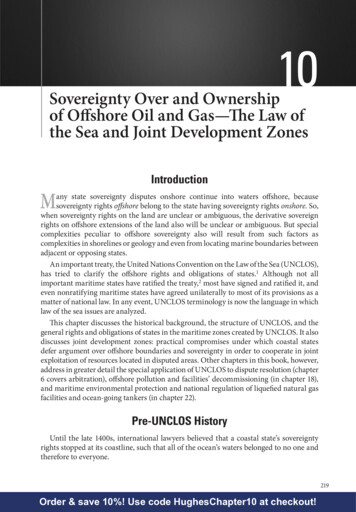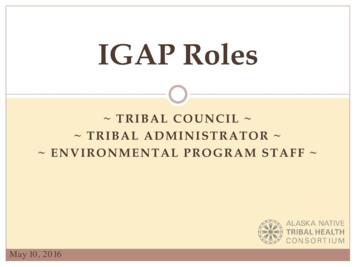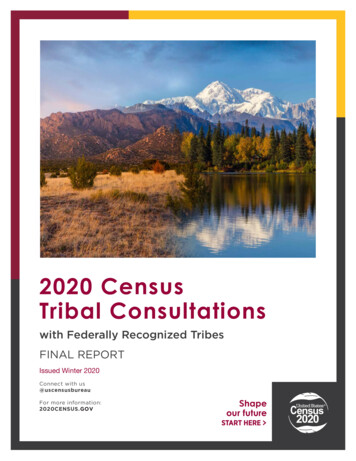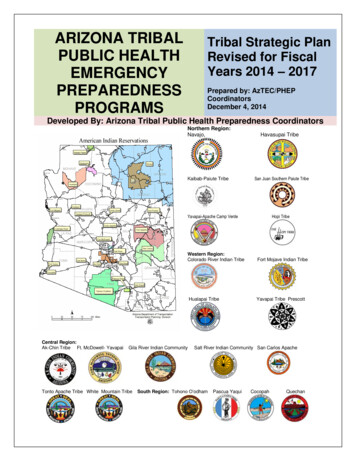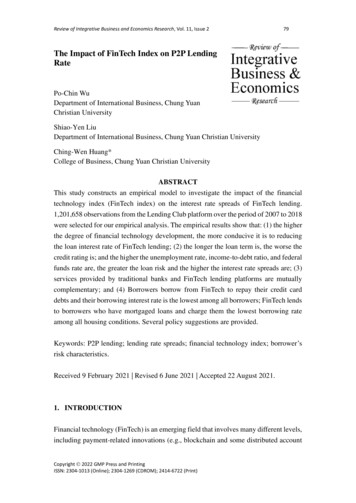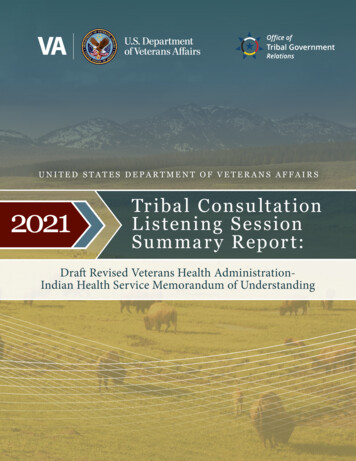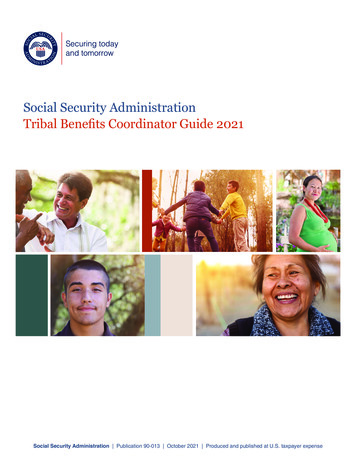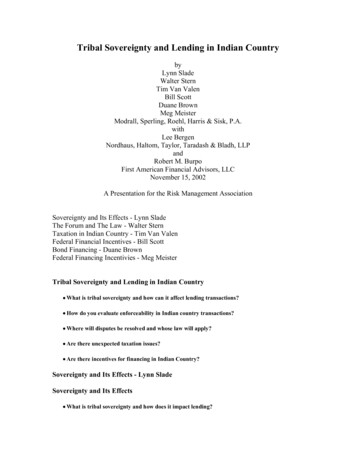
Transcription
Tribal Sovereignty and Lending in Indian CountrybyLynn SladeWalter SternTim Van ValenBill ScottDuane BrownMeg MeisterModrall, Sperling, Roehl, Harris & Sisk, P.A.withLee BergenNordhaus, Haltom, Taylor, Taradash & Bladh, LLPandRobert M. BurpoFirst American Financial Advisors, LLCNovember 15, 2002A Presentation for the Risk Management AssociationSovereignty and Its Effects - Lynn SladeThe Forum and The Law - Walter SternTaxation in Indian Country - Tim Van ValenFederal Financial Incentives - Bill ScottBond Financing - Duane BrownFederal Financing Incentivies - Meg MeisterTribal Sovereignty and Lending in Indian Country What is tribal sovereignty and how can it affect lending transactions? How do you evaluate enforceability in Indian country transactions? Where will disputes be resolved and whose law will apply? Are there unexpected taxation issues? Are there incentives for financing in Indian Country?Sovereignty and Its Effects - Lynn SladeSovereignty and Its Effects What is tribal sovereignty and how does it impact lending?
Defining Tribal Sovereignty Tribes and Pueblo are "Domestic Dependent Nations" Tribes and Pueblos retain some sovereign powers Immunity from suit, like States and United States Governmental Powers Tribes and Pueblos are subject to over-riding federal powerThe Changing Federal Vision of Tribes and Sovereignty Treaty Period "Assimilation" Periods Indian Reorganization Act Period Self-Determination Period Rehnquist CourtFederal Approval of Contracts US/Tribe relationship akin to trustee-beneficiary relationship Contracts “that encumber tribal lands” for a 7 year period must be approved by BIA Gaming management contracts must be approved by NIGC Statutory approvals required; can require environmental reviews and affect timing oftransaction Effect of inadequate review Interpretation of contract ambiguities to favor tribes Agreements voidable without valid approval Federal approval of mortgages of tribal lands leased under 25 U.S.C. § 415 Trend towards providing tribes with authority to avoid Secretarial approvalTribal Regulatory and Taxing Jurisdiction Tribes have inherent power over members
Tribes generally lack power over non-members unlesso The non-member enters into a consensual relationshipo Impact on fundamental health, welfare, and political integrityo Activity on “tribal lands” Tribes have no criminal jurisdiction over non-Indians Tribal jurisdiction over non-Indians can cover broad areaso Commercial lawo Tort damageso Environmental regulationo Employment regulationo Court jurisdictiono Taxing powerRe-examining Sovereignty in an Era of Change The evolving vision of the tribe The changing role of BIA The effect of tribal competence and successo Variations among Tribes or PueblosWho are the Key Players Tribes (i.e., Navajo Nation, Jicarilla, Mescalero) or Pueblos (e.g., Pueblos of Sandia, Santa Ana,and Isleta)o Governor/Presidento Councilo Business Managers Tribal or Pueblo-owned corporations Transactions with individual Indians
Private business entities contracting with Tribe or Pueblo Federal trustee: Interior Department/ Bureau of Indian Affairs Transactions with individual Indians Determine who need to be involved on a case-by-case basisSelf-Determination and the Lender New structures for transactions based on a partnership modelo Joint ventureo Management contracts Creative approaches to addressing sovereignty issuesSovereignty and Its Effects Questions?Enforceability in Indian Country With Whom Are You Contracting and How Can You Maximize Enforceability?Enforceability in Indian Country Transactions Identity and attributes of contracting party Necessary contractual approvals Waiver of immunity from suit and stipulations to effective remediesIdentity and Attributes of Contracting Party Indian Tribe or Puebloo IRA Section 16 Tribe: Tribal Constitution will govern authority to execute documentsand define necessary tribal approvalso Non-IRA Tribe: Tribal laws, ordinances, resolutions, codes, customs, traditions andhistory will govern authority to execute documents and define necessary tribalapprovals Federally Chartered Corporationo IRA Section 17 empowers the Secretary of the Interior to issue a federal charter ofincorporation for a tribal business entity
Tribally Chartered Entityo Tribal laws, ordinances, resolutions, codes, customs, traditions, and history will governauthority to execute documents and define necessary tribal approvals State Chartered Entityo Corporate documents and state law will govern authority to execute and necessarycorporate approvalso Charter will govern authority to execute documents and define necessary corporateapprovals Individual Tribal MemberNecessary Contractual Approvals 25 U.S.C. § 81: Mandates that all contracts that “encumber Indian lands for a period of 7 yearsor more” must be approved by the Secretary of the Interioro Contracts that “do not convey exclusive or nearly exclusive proprietary control overtribal lands for a period of 7 years or more” are not covered by § 81o Secretary must comply with the requirements of the National Environmental PolicyAct before approval of a contract Indian Gaming Regulatory Act mandates that the National Indian Gaming Commissionapprove all management agreements and collateral agreements between outside companiesand Tribes for gaming operationsDue Diligence and the Waiver of Sovereign Immunity As sovereigns, Indian tribes are immune from suit without their consento Immunity applies when the tribe is acting in governmental or business capacity on oroff the reservationo Immunity may apply to tribally-owned corporation Tribal officials may be immune from suit if acting in official capacity Tribally chartered enterprises may be immune depending on whether tribal assets are involvedin the entity’s operations, extent of control of the entity by the tribal government, theauthority of the entity to act on behalf of the tribe, and other factorso If the entity’s charter contains a “sue and be sued” clause, verify that the provision isvalid under tribal law The charter for a Section 17 corporation may contain a sue and be sued clause which waivesimmunity
o Assets may be limitedo Corporation cannot pledge tribal assetso Judgments against the corporation cannot be satisfied out of tribal assets State chartered entities likely are not cloaked with immunityo Assets may be limitedo Entity likely cannot pledge tribal assetso Awards against the entity likely cannot be satisfied out of tribal assets Individual members are not protected by immunity Congress or Tribe or Pueblo may waive the immunity from suito Waiver must be in writing and must be clear and unequivocalo Waiver may be broad or limited to particular subject or particular tribunalo Waiver should be tailored to work for the choice of forum and enforcement provisionsprovided in the agreementsThe Forum and The Law - Walter SternSubjects Lawyers Love andBankers Ha.Will Learn to LoveThe Forum and the Law Where Will Disputes Be Resolved, Whose Law Will Apply and Other Issues?Disclaimer “We fall short of presenting all, or even a goodly part, of the news each day that a citizen wouldneed to intelligently exercise his franchise in this democracy. So as he depends more andmore on us, presumably the depth of knowledge of the average man is diminished. Thisclearly can lead to a disaster in democracy.” - Walter CronkiteThe Choices: Forum for Dispute Resolution Federal Court State Court
Tribal/Pueblo Court Alternative Dispute Resolution; ArbitrationOne View of the Appropriate Forum “. . .Not for 5 Million, Not for 500 Million.[should we waive any attribute of sovereignty]” Representative of Navajo NationThe Forum for Dispute Resolution Federal Courts:o Courts of limited jurisdiction, limited to cases involving: Diversity of citizenship Federal questionsFederal Court Jurisdiction Diversity of Citizenship:o Permits suits between citizens of different stateso Indian tribes or Pueblos are not considered citizens of any stateo Tribal corporations may be citizens of a state depending on how and where they areincorporatedo 75,000 minimum amount in dispute Federal Questiono Dispute is resolved by reference to federal laws, treaties or the Constitution; “arisingunder” federal lawo No 75,000 requiremento Most contracts with tribes or Pueblos likely do not “arise under” federal law Summary:o Unless arrangement is with a corporate or similar entity organized under the laws of astate, diversity jurisdiction will not be presento Generally, contract disputes will not “arise under” federal law
o Federal court jurisdiction likely will not be available, even if the contract provides forfederal jurisdictionExhaustion of Tribal Remedies National Farmers Union Ins. Cos. v. Crow Tribe of Indians (1985):o Deference to policy supporting tribal self-government and self-determinationo Permit tribal/Pueblo court to determine its judicial authority firsto Orderly administration of justiceo Several exceptions existo Federal court review may be available latero Scope of federal review is uncertainState Court Jurisdiction Courts of general jurisdiction Traditionally, tribes and Pueblos are suspicious of state courts Likely that tribal/ Pueblo entity will not agree to state court jurisdiction for dispute resolution Even if the parties agree, there are unique limitations on the jurisdiction of state courts in theIndian law context United States Supreme Court decision in Williams v. Lee (1959):o State courts lack jurisdiction over suits brought by non-Indians against Indiansconcerning matters arising in Indian country when such jurisdiction would infringe“on the right of reservation Indians to make their own laws and be governed bythem” Impact or import of Williams v. Lee is uncertain today, but one must recognize the possiblelimitationTribal Court Jurisdiction “Generalizations are odious” Tribal courts are not courts of general jurisdiction, Nevada v. Hicks (2001) Traditionally, non-Indians have been as suspicious of tribal courts as Indians have been of statecourts
Many tribal and Pueblo courts only recently have asserted jurisdiction over non-members ornon-Indians Some Pueblo courts remain as “traditional” courts, exercising jurisdiction only over disputesbetween members Pueblo of Santo Domingo situation: Reano (“the good, the bad ”) Even those Pueblo courts exercising jurisdiction over non-Indians lack much of a “trackrecord” Some Pueblo courts are not dissociated from the Pueblo political structure; e.g., appeals to thePueblo Council Factors to Consider in Evaluating Whether to Use Tribal Courts to Resolve Disputes:o Structure of court system and relationship to the contracting partyo Background and experience of the judgeso Track record in resolving the types of disputes likely to ariseo Rules of procedure and evidence Factors to Consider in Evaluating Whether to Use Tribal Courts to Resolve Disputes (cont.):o Availability of prior decisionso Authority to apply the parties’ choice of lawAlternative Dispute Resolution Pre-Dispute Good Faith Negotiation or Mediation Peacemaker (and Similar) Courts ArbitrationArbitration Viewed by the parties as “neutral” forum Consent to arbitration may be a waiver of immunity Flexible; contract provision can be drafted to fit the needs of the parties Warning: Draft carefully to avoid battle over arbitrability of dispute and the properarbitration procedure; consider www.adr.org as resource
Still must face the need for confirmation or review of the arbitration decision by a court(“court of competent jurisdiction”)Choice of Law What law is there? The primary choices are:o Stateo Tribalo Federal State Law:o Generally, well developed and understoodo Relatively easy to findo Stable and predictable Tribal Law:o Generally, not well developed or understoodo Not easy to findo Not easy to predicto May not be written, e.g., custom and practiceo Navajo Nation Code: best-developed tribal commercial codeThe Forum and the Law “The secret of getting ahead is getting started. The secret of getting started is breaking yourcomplex, overwhelming tasks into small manageable tasks, and then starting on the firstone.” - Mark TwainGeneral Recommendations Measures to Address Some of the Issues We Have Discussed Understand cultural differences and each side’s goals and perspectives Carefully review all applicable federal, tribal, state and local laws, regulations, and policies Confirm the identity and status of the entity with whom you are dealing
o Carefully review all applicable governing documents Obtain an appropriate waiver or immunity from suit Obtain a waiver on any potential exhaustion of tribal remedies requirement (potential trap forthe unwary) Obtain all necessary federal and tribal contractual approvals Include choice of law, choice of forum and dispute resolution provisions in contract documentso Address collateralization, perfection of liens, foreclosure procedures and other similarissues as part of the choice of law provisionso If it is important, spell it out; ambiguities favor the Tribe/PuebloThe Forum and the Law Applied: Review of Lousy Contract Terms “Applicant agrees, consents and submits to the non-exclusive jurisdiction of any state or federalcourt located in the state . Applicant waives any right to transfer or change the venue ofany litigation filed in such courts.” Comments:o Enforcement is problematic; parties cannot confer jurisdictiono Applicant can file suit in Pueblo court “ all suits will be brought in Bernalillo County, New Mexico” Comment:o If a tribe or Pueblo were located in that county, the suit could be brought inTribal/Pueblo court “Applicant agrees to pay interest of % or the highest rate permitted by law, whichever isless .” Commentso Whose lawo Does tribal or Pueblo law permit any interestThe Forum and the Law: Final Thought Don’t Believe Everything You Hear:o Example: “Employment is not important.”
o Former Representative of Navajo Nation,o where unemployment runs in theo neighborhood of 57%Taxation In Indian Country - Tim Van ValenIndian Country Tax Issues Tribal taxation State and Local taxation Federal taxation Indian Country tax issues are driven by federal Indian lawo Tribal sovereigntyo Federal statutory pre-emptiono Territorial/Geographical component to tax issueso PoliticsKey Questions to Consider in Indian Country Tax Analysis Where? Who? How?Tribal Jurisdiction to Tax in Indian Country Where?o “An Indian tribe’s sovereign power to tax-whatever its derivation-reaches no furtherthan tribal land”o Activities on non-Indian fee lands within reservations and pueblos are not subject toIndian taxing jurisdiction Who?o Tribal members, entities and businesses on tribal lands Often not fully exercised
o Non-Indians engaging in activities on tribal lands Conduct with effect on political integrity, economic security,health or welfare of a tribe Consensual relationship– “Commercial dealings, contracts, leases or other arrangements”– Tribe must have a nexus or relationship with the non-Indian consensual relationship at issue How?o Very carefullyo Each tribe differento Plan ahead to minimize tax impactso Document the transactions well to identify who does what whereo Keep the documents for at least 7 years.Tribal Authority to Tax in Indian Country Sales/gross receipts taxes Business activity tax Severance taxes Property tax Possessory interest taxState Authority to Tax in Indian Country Some non-Indian activities on Indian lands Non-Indian to non-Indian transactions are taxable by State Non-Indian property interests taxable by state Potential for dual taxation by State and tribes Non-Indian to Indian transaction on not taxable by state if:o Sale occurs on tribal land
o Sale to member of tribe, tribal entity or tribal businesso Rule applies to goods or services (at least in New Mexico) Indian transactions, activities and property off of tribal lands are subject to state and localtaxation Be careful with non-taxability assumptions if there is an off-reservation/pueblo component to atransaction Those who contractor with federal agencies for work on tribal lands are generally subject tostate taxationo Exemption from taxation generally limited to transactions with tribe or tribal entityo Limited exception for contractors under some federal programs closely related topervasive federal interestNew Mexico Gross Receipts Tax Generally applies to a seller’s receipts from a sale of services, goods and leasing in New Mexico Can not be imposed on tribes, tribal entities or tribal members for transactions on Indian lands Statutes provide ability to eliminate double taxation on transactional taxes for some puebloso Santa Clara, Isleta, Laguna, Nambe, Sandia and Santa Anao Requires reciprocity Coal sales from Navajo lands Construction specific deductionso Receipts from sale of construction materials to contractor for project on tribal lands Does not require completed project be taxable Requires Type 6 NTTC Need to document well for auditNew Mexico Compensating Tax Generally applies to commercial use of property in New Mexico purchased outside of NewMexico and thus not subject to gross receipts tax Does not apply to fixtures on Indian lands
Interesting question as to whether it applies to off-reservation/pueblo use of propertypurchased on Indian lands free from gross receipts taxNew Mexico Personal Income Tax Does not apply to income of tribal members, living on tribal land for employment on tribal landNew Mexico Corporate Income Tax Intergovernmental business tax credito Business activities of a new (post –7/1/97) facility on Indian lands of a “manufactureror processor” or a “grower”o 50% of lesser of all tribal taxes imposed on “income” or 50% of taxpayer’s NewMexico corporate income tax from new business on Indian lands Apportionment formula tied to capital investment and payrollfor businesses with New Mexico activity on and off of IndianlandsNew Mexico Property Tax Does not apply to Indian lands and property on Indian land Applies to non-Indian property on Indian land Applies to non-Indian leasehold interest on Indian landFederal Corporate Income Tax Accelerated depreciation provisions currently in effect for property placed in service before12/31/04o Generally applies to property primarily used on Indian lands for conduct of a trade orbusinesso Applies to some Tribal infrastructure related property located off of Tribal lands Indian Employment Credito 20% of the excess, if any, of the sum of qualified wages and health insurance costs inany taxable year over the sum of such amounts incurred by the employer incalendar year 1993o Capped at 20,000 per employeeo Does not apply to wages and benefits of an employee who has more than 30,000 inwages paid by employer
Indian Country Tax Tips Organize and document transaction with tax issues in mind Think ahead:o Where does transaction occur?o Where does delivery occur?o Who is the buyer?o Who is the seller? Work with tribes and pueblos, suppliers, subcontractors and buyers Dot the “I’s” and cross the “T’s”Federal Financial Incentives - Bill ScottAccelerated Depreciation, 26 U.S.C. § 168(j)(4) “Qualified Indian reservation property” – property “used by the tax payer predominantly inthe active conduct of a trade or business within an Indian reservation” “Qualified infrastructure property” – property which “(i) benefits the tribal infrastructure, (ii)is available to the general public, (iii) is placed in service in connection with the tax payer’sactive conduct of a trade or business within an Indian reservation.” Examples: roads, powerlines, water systems, railroad spurs, and communication facilities Excludes property outside an Indian reservation “on a regular basis” and property “placed inservice for purposes of conducting or housing” gaming Currently slated to expire in December 2004Tax Credits for Employers of Indians on Indian Lands, 26 U.S.C. § 45 A current year business tax credit in “an amount equal to 20% of the excess (if any) of (1) thesum of (A) the qualified wages paid or incurred during such taxable year, plus (B) qualifiedemployee health insurance costs paid or incurred during such taxable year, over (2) the sumof the qualified wages and qualified employee health insurance costs . . . which were paid orincurred by the employer (or any predecessor) during calendar year 1993” Currently slated to expire in December 2004 Employee must:o be an enrolled member or the spouse of an enrolled member of an Indian tribe
o perform “substantially all” of their services in a “trade or business” within an Indianreservationo must have a “principle place of abode” on or near the reservation while performingsuch services Excludes:o employees who are 5-percent or more owners or are engaged in gamingo receive wages in excess of 30,000 (adjusted for inflation)Indian Employment, Training and Related Services, 25 U.S.C. § 3401, et seq Provides a mechanism for a private company to garner a minimum of two years of service froman employee, while only paying for one year of wages plus training costsProposed Indian Reservation Jobs and Investment Act of 2001 (H.R. 177 and S. 558) Would provide a tax credit for qualified investment in “qualified Indian reservation property”-- reservation personal property, new reservation construction property, or reservationinfrastructure investment Excludes gaming facilities The amount of the credit available would be adjusted according to the unemployment rate onthe applicable Indian reservationHUBZones Program, Small Business Reauthorization Act, 15 U.S.C. § 632 Provides assistance and preference in the receipt of federal procurement contracts. Lands within “Indian country” may be included within the definition of a “historicallyunderutilized business zone” A small business concern can be one “that is owned in part by one or more tribal governments,or by a corporation that is wholly owned by one or more Indian tribal governments” Must certify:o That not less than 35% of the employees reside within a HUBZone, and that thebusiness will attempt to maintain this percentage throughout the course of anyfederal contract awardedo With regard to subcontracts, that 50% of the personnel costs will be expended for itsown employees or employees of another HUBZone small business concern, and that50% of the manufacturing costs for supplies will be incurred in a HUBZoneEnergy Resource Development on Indian Reservations, 25 U.S.C. § 3500 et seq.
Requires the Secretary of Energy too Establish and implement a demonstration program to assist Indian tribes in pursuingenergy self-sufficiency and to promote the development of a vertically integratedenergy industry on Indian reservationso Provide development grants to Indian tribes or joint ventures which are 51 percent ormore controlled by an Indian tribe to help tribes obtain managerial and technicalcapability to develop the energy resources on Indian reservations Provide grants, not to exceed 50% of the project costs, for vertical integration projectsincluding projects involving solar and wind energy, oil refineries, the generation andtransmission of electricity, hydroelectricity, cogeneration, natural gas distribution, and“clean, innovative uses of coal” “The Secretary may grant financial assistance to Indian tribal governments, or private sectorpersons working in cooperation with Indian tribal governments, to carry out projects toevaluate the feasibility of, develop options for, and encourage the adoption of energyefficiency and renewable energy projects on Indian reservations.”Energy Policy Act of 2002 (H.R. 4) Would establish a loan guaranty program for loans made to Indian tribes for energydevelopment, including the planning and construction of generating stations andtransmission and delivery facilities Would provide a federal purchase preference be given to energy resources produced byorganizations partly or wholly controlled by tribal governments Would permit Indian tribes to grant leases for energy facilities and for rights-of-way forpipelines and transmission lines serving an electric generation, transmission or distributionfacility located on tribal land, or a facility that processes or refines energy resourcesdeveloped on tribal lands without the prior approval of the Secretary of the Interior if thelease or rights-of-way are executed under regulations developed by the tribe and approvedby the Secretary.Native American Business Development Trade Promotion and Tourism Act of 2000,25 U.S.C. § 4301 et seq “To promote private investment in the economies of Indian tribes and to encourage thesustainable development of resources of Indian tribes and Indian-owned businesses” Office of Native American Business Development coordinates federal programs for businessand economic development assistance to Indians, and runs new export and trade promotiontourism demonstration project programs under the Act “Indian-owned business” means an entity organized for the conduct of trade or commerce withrespect to which at least 50% of the property interests of the entity are owned by Indians orIndian tribesIndian Revolving Loan Fund, 25 U.S.C. § 1461 et seq.
Established “to provide credit that is not available from private money markets, or tosupplement funds from private lenders” Loans may be made for any purpose which promotes the economic development” of individualIndian borrower or Indian organization and its members Loans may be made in certain circumstances to finance “economic enterprises,” which aredefined to have at least 51 percent Indian ownership. Not presently funded and may not be funded in the future.Bond Financing - Duane BrownIndian Tribal Government Tax Status Act, 26 U.S.C. § 7871 Allows qualifying Indian tribal governments to issue tax exempt debt under Internal RevenueCode rules similar to those for state governments, cities, counties and other governmentalagencies Two types of tax-exempt bonds permittedo Governmental purpose bondso Private activity bonds for certain tribally owned manufacturing facilities Governmental Purpose Bondso May be issued “only if such obligation is part of an issue substantially all of theproceeds of which are to be used in the exercise of any essential governmentalfunction.”o Essential governmental function “shall not include any function which is notcustomarily performed by State and local governments with general taxing powers.” Governmental Purpose Bondso Schoolso Librarieso Tribal administrative buildingso Jailso Parkso Convention facilitieso Housing projects owned by the tribe
Private Activity Bondso Tribal government must issue the bondso 95% or more of net proceeds must be used to finance a manufacturing facilityo Tribal government must own and operate facilityo Facility must be located on land which has been held in trust for the benefit of thetribe for at least 5 years immediately preceding bond issuanceo Must satisfy a detailed annual employment and wage test Tribal government must issue bonds Tribe must own and operate the facility Facility must be located on land which has been held in trust for the benefit of the tribe for atleast 5 years immediately preceding the issuance of the bonds Employment/wage requirement:o “as of the close of each calendar year . . . , the aggregate face amount of all outstandingtax-exempt private activity bonds issued to provide financing for the . . .facility isnot more than 20 times greater than the aggregate wages . . . paid during thepreceding calendar year to individuals (who are enrolled members of the Indiantribe of the issuer or the spouse of any such member) for services rendered” at suchfacilityFederal Financing Incentives - Meg MeisterIndian Financing Act of 1974 Loan Guaranty and Insurance ProgramAdministered through BIA Offices Local Contact:o Jerry Ryburno Bureau of Indian Affairso Plaza Maya Building, Suite 103o 346-7581Who is an Eligible Borrower?
Individual Indian Tribe/ Pueblo Entity 51% owned by either Indian, Tribe or Pueblo Borrower must have 20% equity interest in business immediately after loan is made Can’t otherwise qualify for financing without programWho is an Eligible Lender? Regularly makes loans Capable of evaluating and servicing loans Otherwise acceptable to BIA BUT NOT Agency or instrumentality of federal government Lender that borrows from federal government to make loans (except borrowing from federalreserve) Lender that does not include interest on loans in gross income for purposes of Ch.1 Title 26 ofUS Code Lender who originates loans but does not hold loansHow Does the Program Work? Guaranty- up to 90% of unpaid principal and interest due Insurance- reimburse for losses up to 15% of the aggregate of all such loans from a lender(limit 90% of the loss of any one loan) Obtain prior approval as a lender by entering into agreement with the BIACost Guaranty- 2% of guaranteed principal amount Insurance- 1% of insured principal amountBIA Submission for a Loan Guaranty Indication of need and minimum guaranty lender will accept
Copy of loan fileBIA Submission for Insurance No prior approval required for loans up to 100,000, except if a portion of an insured loanpackage for one borrower greater than 100,000 If loan greater than 100,000, must submit an application and all of the same information asfor loan guarantyProhibited Loan Terms No “points”, loan origination fees Can charge annual servicing fee so long as not included in principal of loan and does not bearinterest No third party charges, except legal fees, broker commissions, inspections, title insurance, keyman insurance, and others No term beyond 30 years No payments less frequent tha
Indian law context United States Supreme Court decision in Williams v. Lee (1959): o State courts lack jurisdiction over suits brought by non-Indians against Indians concerning matters arising in Indian country when such jurisdiction would infringe "on the right of reservation Indians to make their own laws and be governed by them"
